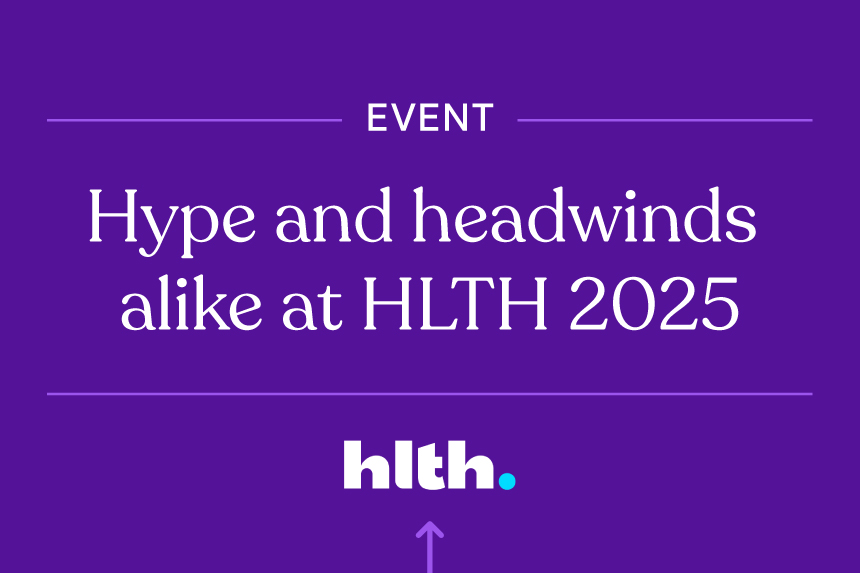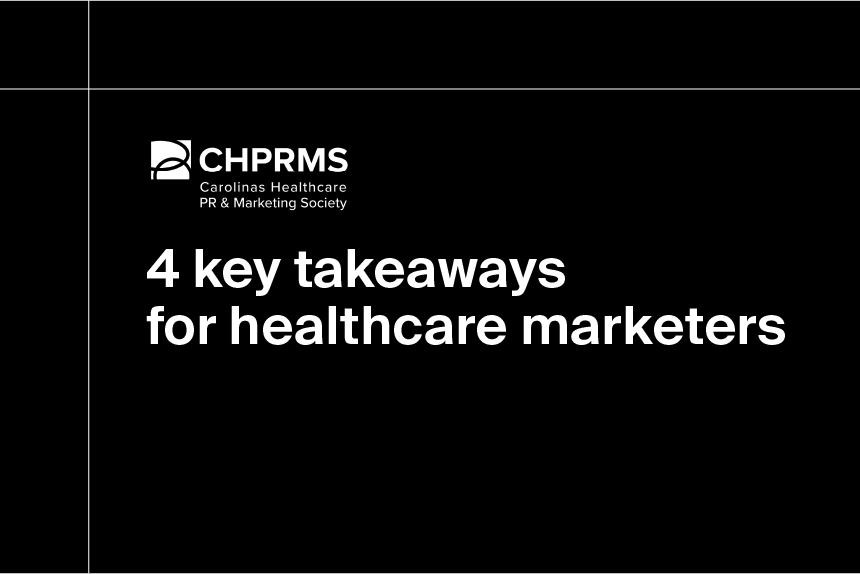HLTH is always a high point on the calendar, and this year’s event in Las Vegas was no exception.
For the Definitive Healthcare team, it was a chance to meet face-to-face with customers and partners, share how we’re helping organizations use data to see the market from any angle, and explore how real-world intelligence can uncover high-value opportunities and drive smarter growth heading into 2026.
But if previous HLTH events felt like a pure celebration of innovation, this year’s tone was a bit more grounded. Yes, the energy was still high, especially around the latest AI innovations and cutting-edge technologies, but there was also a noticeable undercurrent of concern.
From mainstage keynotes to panel discussions, attendees grappled with tough challenges around the rising cost of care, millions losing Medicaid coverage, and the ongoing government shutdown, among other concerns that were top of mind.
Still, HLTH 2025 was a showcase of bold ideas and forward momentum, even in the face of real headwinds. Couldn’t make it to Vegas this year? No problem, below are some of the biggest takeaways and impressions our team brought back from the show floor.
AI is still the headliner, and the hype isn’t slowing down
Let’s get the obvious out of the way: AI dominated the conversation at HLTH 2025, just as it has at nearly every major healthcare conference this year. But this wasn’t just more buzz—it was clear that AI is shifting from potential to practical use across nearly every corner of the industry.
AI agents lead the way
Healthcare organizations are embracing AI tools at scale, and a veritable avalanche of new AI agents was announced at the event. Across the show floor, companies unveiled new tools built to address very specific operational or clinical pain points. A few standouts:
- Arbital Health’s Merlin AI is a value-based care assistant that helps healthcare organizations cut through the fog of actuarial models. It aims to provide practical guidance by explaining performance drivers in plain language and recommending next best actions.
- Ellipsis Health, in collaboration with NVIDIA, is expanding the emotional intelligence of its AI care manager, Sage, to better engage patients and extend staffing capacity through proactive check-ins and support.
- GE HealthCare, Duke Health, and The Queen’s Health Systems are teaming up to develop an AI-driven hospital operations platform focused on improving patient flow, resource utilization, and overall care quality.
- Vital announced its new AI platform, Vital Urgent Care, that provides patients with real-time updates, wait times, and personalized guidance in urgent care settings.
The diversity of these agents points to a few clear trends. Namely, collaboration is king. Many of these solutions are coming to life through partnerships: Health systems, tech companies, and AI developers combining forces to build faster and smarter.
AI is also being embedded at every layer of care delivery. From patient-facing tools that streamline urgent care visits, to backend platforms that optimize hospital operations, the use cases for AI are rapidly expanding.
Finally, transparency is a top priority among some of the AI innovations coming to the market. If AI is going to guide decisions in high-stakes environments, it needs to earn trust. That starts with making its reasoning visible and its outputs accountable.
Can AI lighten the load?
While it’s exciting to see AI break into new markets, where it remains most impactful is in the trenches of healthcare, like billing and documentation, and daily workflows where inefficiencies stack up and burnout runs high.
In revenue cycle management, billing, and coding, AI is streamlining some of healthcare’s most time-consuming tasks, helping teams reduce errors, recover revenue faster, and free up staff for higher-value work. On the front end, tools are automating patient eligibility checks, generating real-time estimates, and reducing data entry errors at registration. In the middle of the cycle, natural language processing (NLP) is powering smarter coding suggestions, while machine learning models flag claims likely to be denied—before they’re even submitted. On the back end, robotic process automation (RPA) is accelerating remittance posting, payor follow-ups, and reconciliation.
Ambient documentation also stood out as an area where AI can step in to alleviate the administrative burdens physicians must manage daily. These tools, which record conversations between patients and clinicians and then generate clinical notes, have been around for a while, but were clunky, slow, inorganic, and sometimes inaccurate. AI and natural language processing are making the process faster and more accurate, enabling more face-to-face conversations while AI quietly handles the notetaking in the background.
And of course, AI continues to gain traction in more advanced, data-intensive domains. As we’ve covered in the past, it’s helping radiologists detect anomalies earlier and with greater precision and driving breakthroughs in pharmaceutical manufacturing from drug discovery to side effect prediction to supply chain optimization.
The cost of care is a major concern
Entrepreneur Mark Cuban headlined HLTH this year and kicked off the event with a powerful discussion on the rising cost of care and prescription drugs. As the owner of Cost Plus Drugs, a company that sells low-cost prescriptions online, Cuban put a spotlight on systemic inefficiencies and pharmacy benefit managers for inflated drug prices that keep care unaffordable for millions of Americans.
His message wasn’t an outlier. Healthcare executives made it known at various panel discussions that they understand that too many people aren’t pursuing care because of high prices while others resort to going into debt simply to get the care they need.
As we outlined in our 2026 healthcare trends eBook, there are several forces contributing to high healthcare costs:
- An aging U.S. population is increasing demand for care across specialties and settings
- Chronic disease rates continue to climb, requiring long-term, resource-intensive management
- The GLP-1 boom is reshaping pharmaceutical spending, with employers bracing for a projected 10% increase in healthcare costs in 2026
The challenge is that this trend is already impacting budgets in organizations across the industry and influencing how patients access care and the benefits the insured receive. Cuban acknowledged how complex the issue is and that it won’t be solved overnight. Still, it is a positive sign that the high cost of care held significant space at HLTH. Providers, payors, life sciences companies, and tech companies will have to work together to find a solution that works.
Policy instability is creating real anxiety across the industry
It’s easy to focus on what’s new and exciting at HLTH. But this year, the ongoing government shutdown and looming shifts in healthcare policy were top of mind for some leaders who shared their anxieties during the conference.
To summarize some of their chief concerns:
- Medicare waivers supporting telehealth services at certain providers expired October 1, disrupting patients’ access to care due to a lapse in renewing the federal spending bill.
- Similarly, the Hospital-at-Home waiver has yet to be reinstated, pushing the financial risk onto hospitals by making it no longer possible to bill Medicare or Medicaid for acute care services rendered at home.
- The tax credits that help millions afford insurance coverage under the Affordable Care Act are set to expire at the end of 2025—and if they lapse, it’s projected that millions could lose access to affordable care.
- Over the next decade, an estimated 10 million people are expected to lose Medicaid coverage due to massive healthcare cuts introduced in the One Big Beautiful Bill Act.
Still, even amid this uncertainty, the conversations at HLTH showed that healthcare leaders aren’t standing still. Many are already thinking ahead, exploring alternative care models, pushing for regulatory clarity, and finding ways to adapt through innovation and collaboration. If anything, the turbulence is reinforcing how critical it is to build systems that are flexible, patient-centered, and grounded in data.
Good data builds momentum
HLTH 2025 reminded us that the future of healthcare will belong to the organizations that can see clearly, move strategically, and act with confidence. To power big, innovative ideas or bring cutting-edge technologies or therapies to market, leaders need clear, comprehensive data. It’s critical to making smarter decisions faster, and that’s exactly what Definitive Healthcare solutions are built to provide.
For providers, tech innovators, and businesses across the healthcare ecosystem, our data products and solutions make it easier to see the market from every angle, know where demand is growing, identify who’s ready to buy and where care gaps exist, and figure out how your solution fits in. Book a demo with Definitive Healthcare today to see how our data can make a difference in your organization.




